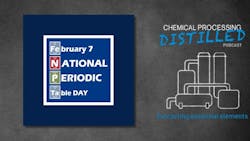Transcript
Get out your party hats – it’s National Periodic Table Day!
Welcome to Chemical Processing’s Distilled podcast -- This podcast and its transcript can be found at chemicalprocessing.com. You can also download this podcast on your favorite player.
I’m Traci Purdum, editor-in-chief of CP.
On Feb. 7, 2016, a teacher from Kentucky founded the National Periodic Table Day to toast the publishing of scientist John Newlands’ periodic table of elements on February 7, 1863.
Adding to the prominence of the day, Dmitri Mendeleev, who formulated the present-day periodic table in 1869, was born on February 8, 1834. (I’m guessing the teacher had to flip a coin for which day made the grade). Mendeleev claimed to have conceived of the table's structure in a dream, where he saw the elements fall into place in an organized pattern, prompting him to quickly write it down upon waking up.
Many of you know that I am a fan of the periodic table – I’ve written about it at least a dozen times over the years.
In a blog post from 2019 I noted that my fascination with the table began in the 11th grade. One of my favorite teachers, Mr. Venefra, had the chart proudly displayed in his classroom and I can still picture his animated lectures in front of it. He’d get red-faced when he got really excited -- or really mad. But he always had the same goal: To make his students appreciate chemistry.
The periodic table has been at the core of chemistry. Mendeleev’s table not only classified the known elements, but enabled him to predict those that were missing, along with their physical and chemical properties.
Periodic Table Trivia
Not only is it a tool used by scientists, it has spurred endless amounts of trivia fodder. For example, did you know the only letters not in the periodic table are the letters J and Q?
The reason for their absence? There are no element names or symbols that include the letter "J" in the standard naming system used by the International Union of Pure and Applied Chemistry; essentially, no known element names currently use the letter "J" in their official names.
And while some temporary element names may use "Q" during discovery, no officially recognized element names contain the letter "Q" either.
More trivia -- Francium is the second-rarest element on earth. There are probably no more than a few ounces of it on the planet at any given time. What’s the first? Astatine -- it is the rarest naturally occurring element appearing only as the decay product of various heavier elements.
In 1943, three years after astatine was first synthesized artificially in a nuclear reactor, it was discovered that the element occurs naturally in miniscule amounts in the earth's crust.
Very First Interactive Table
In preparation for National Periodic Table Day in 2022, Los Alamos National Laboratory explored an ahead-of-its-time project
In 1992, when just a handful of webpages populated the newly established World Wide Web, a graduate student at Los Alamos National Laboratory did something extraordinary: he launched one of the web’s first-ever interactive periodic table of elements — and it still exists today.
The elements on the table are clickable, offering users the chance to deep-dive into everything there is to know about them, from their origins and properties to their electron configurations and boiling points.
Over the years, experts from the Laboratory’s Chemistry Division have spiffed up the periodic table a few times with facelifts and redesigns. The table was last updated in 2016 to include four new elements: nihonium (Nh, element 113), moscovium (Mc, element 115), tennessine (Ts, element 117) and oganesson (Og, element 118).
Motörhead Moves Aside
And speaking of those four new elements in 2016, I wrote about the anticipation of naming rights for these newbies via the IUPAC.
One of the contenders that year was Lemmium named after the late Motörhead frontman Lemmy Kilmister who died in 2015. According to the IUPAC's guidelines, elements "can be named after a mythological concept, a mineral, a place or country, a property or a scientist." Lemmy's fans said that he fulfills one, and possibly all, of those requirements.
Lemmium lost out, obviously, but 156,643 people voted in favor of Lemmy as the inspiration.
A New Approach to the Table
In more recent periodic table news, in 2023 a group of academics from the University of Sydney in Australia, set out to explore an Australian First Nations-first approach to understanding the chemical elements. In the Journal of Chemistry Teacher International, the team said it believes that engagement with cultural heritage, ongoing cultures, and the knowledges of this place—the lands on which we work, live, and study—will lead to new ways of understanding the elements and change the way we practice chemistry. The “First Nations first” phrase and approach comes from understanding the unique place that Aboriginal and Torres Strait Islander peoples have in the Australian context.
In their paper they explore how a First Nations-first approach could take place in Sydney on Aboriginal lands. This approach is led by Aboriginal people, engages with culture, and is produced with local knowledge holders. So far, the work has entailed two years of meeting, conversing, and sharing space to determine appropriate ways of working together, interrogating the complexities of the ideas, and to refining their approach to the work. To appreciate the significant shift that a First Nations-first approach represents for chemistry, they consider the legacy of the Periodic Table. They share some reflections on how Indigenous knowledges can contribute to an expanded chemistry curriculum through the recognition of productive cultural tension.
My podcast partner on the Process Safety with Trish & Traci podcast lives in Australia and she and I will be discussing this work more in-depth in a future podcast – so stay tuned.
On the Horizon
And finally, let’s talk about elements 119 and 120, which are both hypothetical, superheavy elements that have not yet been discovered, but are predicted to be the first elements in the eighth row of the periodic table. Scientists are actively trying to synthesize them by smashing atoms together in particle accelerators, but their extreme instability makes detection very difficult.
Based on their position on the periodic table, element 119 is expected to behave like an alkali metal, while element 120 would likely be an alkaline earth metal.
That’s it for today’s periodic table insight
Want to stay on top of important holidays and best practices to help you run more efficient, safe and competitive facilities? Subscribe to this free podcast via your favorite podcast platform. You can also visit us at chemicalprocessing.com for more tools and resources aimed at helping you achieve success.
Thanks for listening to Chemical Processing Distilled – I hope you have a great National Periodic Table Day.
About the Author
Traci Purdum
Editor-in-Chief
Traci Purdum, an award-winning business journalist with extensive experience covering manufacturing and management issues, is a graduate of the Kent State University School of Journalism and Mass Communication, Kent, Ohio, and an alumnus of the Wharton Seminar for Business Journalists, Wharton School of Business, University of Pennsylvania, Philadelphia.

